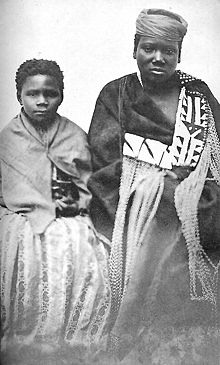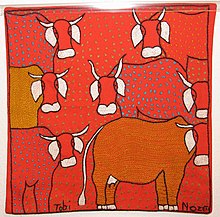Xhosa cattle killing
The Xhosa cattle killing is a crisis cult of the Xhosa in South Africa . It is a desperate cult with devastating consequences.
In 1854 a disease, possibly transmitted by the cattle of the European settlers, spread to the cattle of the Xhosa. Many animals died and the Xhosa explained this with ubuthi , witchcraft.
In May 1856, a girl named Nongqawuse was drawing water from a pond near the mouth of the Gxarha River. On her return, she told her uncle Mhlakaza that she had seen three ghosts by the pond. They told her to tell her village that if the Xhosa killed all of their bewitched cattle , the dead would be resurrected . The entire - also bewitched - harvest should also be destroyed. The day after the destruction, the dead Xhosa would be resurrected to help drive out the whites. Ultimately, the spirits demanded that not a single animal in their herds should survive and that every grain of grain should be destroyed. When this happened, vast numbers of much nicer cattle would emerge from the earth, while large fields of grain, ripe and ready for harvest, would suddenly appear. The dead would be resurrected, problems and diseases would disappear, and all would be given youth and beauty. Infidels and the hated whites would perish that day. This message comes from the late Chief Napakade .
Nongqawuse went home and told the message, but no one believed it. The next day she was walking down the river again with her friend when the strangers approached her again. This time they told her to tell her uncle to come to them. She returned home and told her uncle the message. She described the speaker for the two strangers to him. Nombanda, the girl who accompanied Nongqawuse, testified that although she had obviously spoken to strangers, she herself could not see these strangers. So the uncle went to the designated place. The strangers did not show themselves, but spoke to him. They said they were the strong men who would drive the whites out of the country. They repeated that the Xhosa should first destroy all bewitched matter, then kill all livestock and replace them with healthy animals. The uncle told this message to the chiefs and all of the Xhosa. The simultaneous spread of lung disease among cattle led the Xhosa to believe the message and follow it. The death of the Governor of the Cape Colony , George Cathcart , who died in the Crimean War in 1854 , was seen as further evidence of the prophecy . The Xhosa slaughtered around 400,000 of their livestock.
But the dead did not appear, and therefore no healthy animals either. Tens of thousands of Xhosa starved to death. Thousands more left their homes and looked for food in the Cape Colony . In 1857 alone, the Xhosa population fell from 105,000 to 37,500. It reached its lowest point a year later with 25,916 people. The Xhosa lost not only a large part of their cattle and people of their people, but also around 600,000 acres (2000 km²) of land. The depopulated land was subsequently replenished with European settlers, including members of the German Legion of the British Army that had served in the Crimean War and around 2,000 northern German emigrants.
Even today, the various parties argue about who was to blame for this disaster. The British blame the Xhosa themselves. However, these accuse the British and in particular the then governor of the Cape Republic, George Gray . This is said to have manipulated the girl, Nongqawuse. The historian Jeffrey Brian Peires, who, among other things, examined Grey's personal correspondence, denies this, but does not pronounce him completely free of any guilt. Because it is a certain fact that Gray used the famine of the Xhosa politically in his favor by refusing them any aid.
literature
- Jeffrey Brian Peires : The Dead Wants Arise . Ravan Press, Johannesburg 1989, ISBN 0253205247 .
Web links
- Multi-university project to research the Xhosa cattle killing ( Memento of November 24, 2010 in the Internet Archive ) (English)
- Anette Horn: Nongqawuse and the nation's suicide as an anti-imperial uprising: Elias Canetti and the Xhosa ( Memento of January 18, 2013 in the Internet Archive ); Retrieved December 7, 2013

